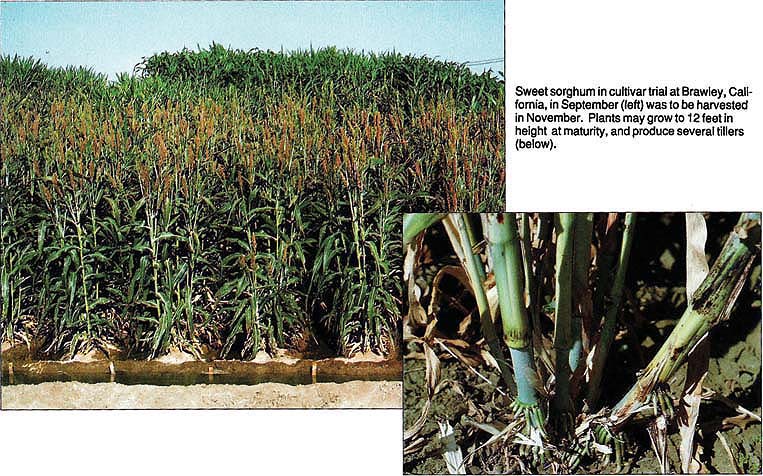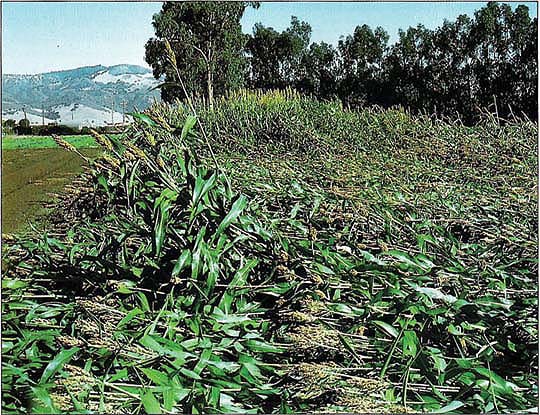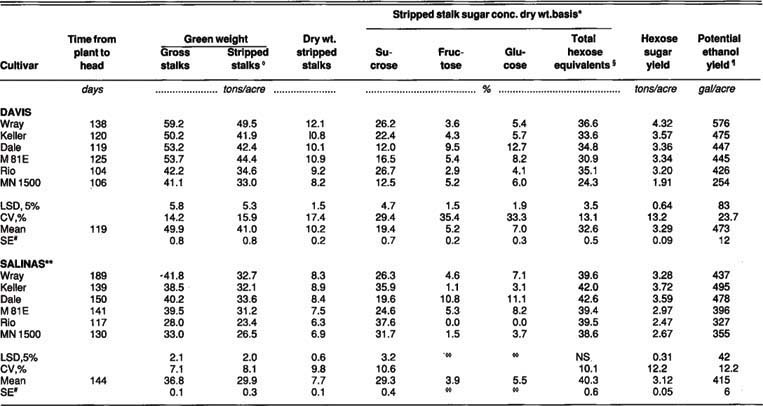All Issues
Sweet sorghum cuItivars for alcohol production
Publication Information
California Agriculture 44(1):14-16.
Published January 01, 1990
PDF | Citation | Permissions
Abstract
Sweet sorghum does well in much of California. Cultivars were tested that showed a potential for producing from 475 to 575 gallons of ethanol per acre.
Full text
Sweet sorghum in cultivar trial at Brawley, California, in September (left) was to be harvested in November. Plants may grow to 12 feet in height at maturity, and produce several tillers (below).
Sweet sorghum has been grown for many years in the southeastern United States in small plantings for making sweet syrup. Plant breeders have developed high-sucrose cultivars to increase the potential of this crop as a sucrose source. This effort has also made sweet sorghum a candidate feed stock for the production of ethanol. Ethanol is added to gasoline to increase the octane rating, reduce pollution, and extend the gasoline supply for internal combustion engines.
The sugars synthesized by sweet sorghum, Sorghum bicolor (L.) Moench., are stored in stems (culms) as is the case with sugracane. Sugarcane, however, requires 12 to 24 months of tropical climate to mature, whereas sweet sorghum can be grown to maturity in 92 to 180 days. It thus can be grown successfully during the warm season of a temperate climate.
To produce alcohol, the juice must be pressed from the sweet sorghum stems and fermented. The alchol is then distilled from the fermentation vat. Bagasse, the residual stalk material, can be used as fuel for the distillation process. At maturity, sweet sorghum produces heads (panicles) bearing seeds. The seed crop is relatively small and is of minor importance in furnishing carbohydrate for fermentation or for use as animal feed. For most cultivars, stalk sugar concentration increases from the milk stage to the soft dough stage of the seed, then declines as the seeds become more mature.
Research at the University of California, Davis, has shown that sweet sorghum has characteristics that favor its use for the production of alcohol. It produces about 23% more fermentable carbohydrate than does field corn, requires only 37% of the fertilizer nitrogen used by corn, and requires about 17% less irrigation water.
Another important consideration in growing this crop is the selection of a welladapted cultivar. From 1980 to 1984, the Agricultural Research Service of the U.S. Department of Agriculture sponsored trials throughout the United States to evaluate six cultivars for potential ethanol production. California was one of the test areas with trials at Davis, Brawley, and Salinas. In this report, we present the comparative yields of the six cultivars grown at Davis and Salinas over a 3-year period. Results from a 1980 Brawley trial are also discussed. Trials at Brawley in 1981 and 1982 were abandoned, because wet and windy conditions caused much lodging and stalk breakage.
Materials and methods
Five of the six cultivars tested, ‘Keller’, ‘Dale’, ‘M81E’, and ‘Rio’, are from U.S. sugar-breeding programs and the other, ‘MN 1500’, is of African origin. The cultivars were grown each year at each location in a randomized complete block design with four replications. Plots were from 20 to 22 feet in length and three rows wide. Row spacing at Salinas was 56 inches in 1981 and 28 inches in the other two years. At Davis, row spacing was 30 inches. Seeds were planted in April or early May at Davis and in late April to early June at Salinas. Shortly after emergence, seedlings were thinned to 4 or 5 inches between plants within rows.
Harvest was in mid-October at Davis and early December at Salinas. The center row of each three-row plot was harvested at Salinas. Stalks were harvested by handcutting at ground level. A 10-plant sample was taken from each plot. The stalks of the sample were stripped of leaves, and the heads removed. The stripped stalks were chopped in small pieces and a subsample of this material was frozen, packed in dry ice, and shipped to the Northern Agricultural Energy Center in Peoria, Illinois, for sugar analysis.
Lodging is a potential problem in growing sweet sorghum. In this trial at Salinas, lodging occurred in November after a rain and wind storm.
Twelve cultivars in a 1980 Brawley test were planted April 30 and harvested November 20. Row spacing was 40 inches, but otherwise experimental methods were similar.
Results and discussion
All cultivars matured faster at Davis than at Salinas, requiring an average of 119 days to head at Davis compared with 144 days at Salinas. Table 1 summarizes 3-year average production at each location. Total biomass is given by the gross green weight of stalks. Stripped stalks are the portion of the biomass to be crushed to express the stalk juice that contains the sugars for fermentation. Stalk sugar concentration is given on a dry weight basis but can be expressed as a percentage of the fresh weight of stalks by multiplying the dry weight sugar percent by the ratio of the weight of dry stripped stalks to fresh stripped stalks. For example, the average fresh weight stalk concentrations of all sugars at Davis and Salinas were 32.6% and 40.3%, respectively. The stalk fresh weight sugar concentrations were: 32.6 (10.2/41.0)=8.1% and 40.3 (7.7/29.9)=10.4%. Compared with sugarbeet, a crop extensively grown in California, these are low sugar concentrations. An improvement in sugar concentration of sweet sorghum would greatly improve the efficiency of the crop as an ethanol feed stock.
Biomass and stripped stalk yields were considerably higher for the warmer climate of Davis, but the higher stalk sugar concentrations at Salinas made total sugar production and potential ethanol yield similar for both locations. The matured height of the stalks at both locations was about the same (10 to 12 feet), but at Davis, near maximum height was reached by late July and resulted in extensive lodging following an early August furrow irrigation. Slower growth at Salinas enabled the stalks to remain upright until late October or early November. The greater lodging at Davis and the resulting loss of leaf area exposed to sunlight may have had some effect in lowering the sugar content.
There were no interactions between cultivar and year at Davis, indicating that the cultivars performed relatively similarly, one to another, in all 3 years. On average, ‘Wray’ was superior for potential ethanol yield. There were statistically significant interactions between cultivar and year at Salinas, but in all years, ‘Wray’ yielded either first or second. At that location, ‘Keller’, ‘Dale’, and ‘Wray’ were the three highest yielding cultivars in terms of potential ethanol yield.
In the 1980 Brawley trial, gross green stalk weight ranged from 26 to 57 tons per acre. The later maturing cultivars, ‘MN 1500’, ‘MER 71-1’, and ‘MER 60-2’, yielded more than 50 tons per acre, whereas the earlier maturing types, ‘Wray’, ‘Ramada’, and ‘Brawley’ were less than 30 tons per acre. Stalk concentration of total soluble solids, estimated from brix readings, ranged from 6.5% for ‘Brandes’ to 22.1% for ‘Keller’. The highest estimated ethanol yields were from ‘MN 1500’, ‘Keller’, ‘MER 71-1’, and ‘MER 60-2’. Stalk height ranged from less than 7 feet for ‘Wray’ to 11.5 feet for ‘MN 1500’.
From these results, it appears that sweet sorghum would produce well in many areas of the state and that most cultivars used in the southern United States would do well here. However, sweet sorghum is sensitive to day length, and cultivar-by-location interactions for maturity were evident. Additional testing would be required to identify the best cultivar for each major production area and for each harvest period within areas.







